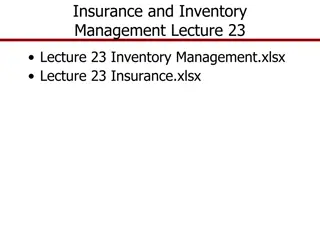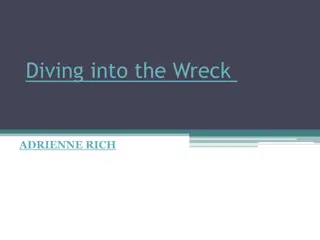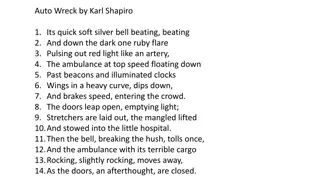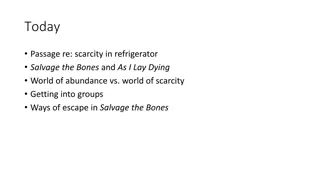The Transition from Salvage to Wreck Removal in Shipowner Insurance
Exploring the uncertain transition from H&M insurance, which insures against loss of value, to P&I insurance, which insures against liability, in cases where a ship faces loss of value and the authorities order wreck removal. The London Arbitration case 4/88 delves into whether shipwrecks necessitate removal and the implications for insurance coverage.
Download Presentation

Please find below an Image/Link to download the presentation.
The content on the website is provided AS IS for your information and personal use only. It may not be sold, licensed, or shared on other websites without obtaining consent from the author. Download presentation by click this link. If you encounter any issues during the download, it is possible that the publisher has removed the file from their server.
E N D
Presentation Transcript
From Salvage to Wreck Removal The uncertain transition from H&M to P&I Richard Sarll
The problem defined Two principal types of shipowner insurance: H&M. Primarily insures against loss of value. P&I. Primarily insures against liability. Where there is a casualty, the ship may: Lose value; and Authorities may order the wreck to be removed. As per Gaskell & Forrest, The Law of Wreck: There is often a somewhat uncertain transition from salvage to wreck removal that represent a transition between the risks and tasks assumed by H&M may also insurers and the Clubs. Very little caselaw exploring the transition! 2
London Arbitration 4/88 Facts Vessel sank whilst under repair at Eastern Anchorage, Singapore. Singapore port authorities ordered removal Salvors engaged, subsequently refloated. Club Rules provided cover against the following liabilities costs and expenses: Removal of wreck (14) Liability which a member may incur in respect of the raising, removal, destruction, lighting or marking of the wreck of (a) an entered ship, less the value (if any) of the wreck itself and of the stores and materials saved. Dispute over whether Club obliged to indemnify. Was it necessary for ship to be a wreck ? Even if ship did not need to be a wreck , was it sufficient that Port Authorities had made removal order? 3
London Arbitration 4/88 Decision Vessel did not need to be a wreck within any technical meaning. If there was a liability to raise, remove, destroy etc. a ship which had sunk, prima facie the Club was liable. However: Even if a CTL, ship might retain a high residual value. In such instances, the costs of removal would be a matter between owners and their hull underwriters. Club cover would only come into question in the extreme case where wreck removal expenses were very high and the residual value was low . What does all of this mean? First let s look at the principles, then points of practice 4
Assessing whether a ship is a CTL Cl. 19, ITC(H) 83: In ascertaining whether the Vessel is a constructive total loss, the insured value shall be taken as the repaired value Cost of salvage operations as from time of incident may be included as part of cost of repair - The Renos [2019] UKSC 29. If shipowner agrees daily rate contract on commercial terms (rather than e.g. LOF), it seems the whole of the cost will rank towards the CTL. The Renos but see Kemp v Halliday. 5
Obtaining the cost of salvage in addition as S&L Even if it has already been used to rank towards the CTL target, the cost of the salvage operations can be recoverable in addition, if it is Sue and Labour. Clause 13, ITC(H) provides: In the case of any loss or misfortune it is the duty of the Assured and their servants and agents to take such measures as may be reasonable for the purpose of averting or minimising a loss which would be recoverable under this insurance. Cl. 13(2) provides that GA losses are not recoverable under the suing and labouring clause. C.f. Rule VI(a), YAR 2016: Expenditure incurred by the parties to the common maritime adventure in the salvage, whether under contract or otherwise, shall be allowed in general provided that the salvage operations were carried out for the purposes of preserving from peril the property involved in the common maritime adventure nature of I.e. a vessel in ballast with no cargo and no charterers bunkers. 6
Can you S&L even when ship is a CTL? - For S&L to be recoverable: - The original peril must continue to operate - There must be a sufficient risk of loss. - Even if Vessel is already a CTL, S&L expenses are recoverable if further damage might: - Lead to ATL; - Diminish vessel s residual value. (Brillante Virtuoso) - Recoverable even if serves dual purpose of compliance with wreck removal order (Standard Life v Ace) 7
What if salvage is GA? According to MIA 1906, there is cover for salvage remuneration paid under contract under Section 64 (Particular Charges) or Section 66 (General average loss); or else under Cl. 11, ITC(H). However, limit imposed by Insured Value would apply. So, salvage remuneration can be used to rank towards CTL target. But, on the face of it, ship s proportion of the remuneration not recoverable in addition. However, ship s proportion of GA is typically deducted as a charge on the proceeds of sale. Hence, provided there is sufficient residual value, shouldn t matter whether the salvage remuneration is GA or Sue and Labour: If S&L, payable in addition; whole amount of proceeds are to be tendered to underwriters. If GA, not payable in addition; but proceeds of sale fall to be reduced. 8
But what if salvage is GA and ship is of nil value? Clause 13(5), ITC(H) 83 When a claim for total loss of the Vessel is admitted under this insurance and expenses have been reasonably incurred in saving or attempting to save the Vessel and other property and there are no proceeds, or the expenses exceed the proceeds, then this insurance shall bear its pro rata share of such proportion of the expenses, or of the expenses in excess of the proceeds, as the case may be, as may reasonably be regarded as having been incurred in respect of the Vessel; but if the Vessel be insured for less than its sound value at the time of the occurrence giving rise to the expenditure, the amount recoverable under this clause shall be reduced in proportion to the under- insurance. 9
Clause 13(5), ITC(H) 83 ingredients (1) Total loss to be paid. (2) Salvors engaged to save both ship and cargo, so S&L not engaged. (3) Ship was not saved, yet there is still a liability to the salvors. (Not no cure no pay !) (4) No proceeds from sale, so can t deduct the liability from the proceeds. (5) Assured will recover under H&M such amount as may reasonably be regarded as having been incurred in respect of the Vessel . (6) Whatever is regarded as incurred in respect of cargo is not covered by H&M. (7) But what does that distinction involve??? 10
Summary of principles Even in a wreck removal situation, there is potentially cover under H&M. Not only can one use the costs of removal to rank towards CTL target. But one can also recover them in addition to indemnity as for total loss:- Removal ops could be S&L. Removal ops could be GA in which case: Shipowner s proportion as a charge on proceeds of sale. Where no proceeds, cl. 13(5) ITCH could assist. Hence statement in London Arbitration 4/88 that Club cover comes into question in extreme case . 11
Problems in practice - Assured may need to maintain wreck to prove case on values or causation. - Average adjusters will make deductions from proceeds typically as from NOA. - Beforehand, charges might be treated as S&L. But might not! - Where wreck removal order, and cover transitions to P&I, interests of H&M insurers in any proceeds often waived. - Instead, proceeds offset against cost of wreck removal operations. 12
Problems in practice cont. P&I underwriters may expect costs incurred prior to wreck removal order to be covered under H&M insurance. But that can depend on whether there are proceeds of sale! Shipowner risks falling in gap between H&M and P&I. 13
Need for new ITC(H) Conditions for S&L unclear. Deductions from proceeds presently unregulated. Cl. 13(5) widely criticised. Potential gap in cover between H&M and P&I. 14
Richard Sarll rsarll@7kbw.co.uk
www.7kbw.co.uk 7 King s Bench Walk, Temple, London EC4Y 7DS +44 20 7910 8300























